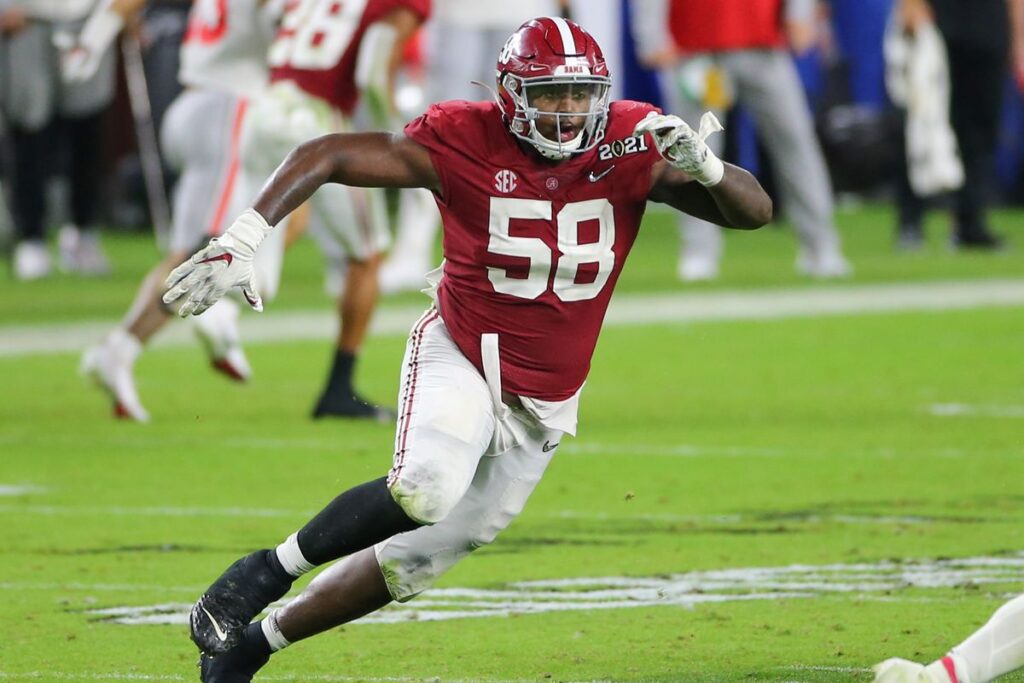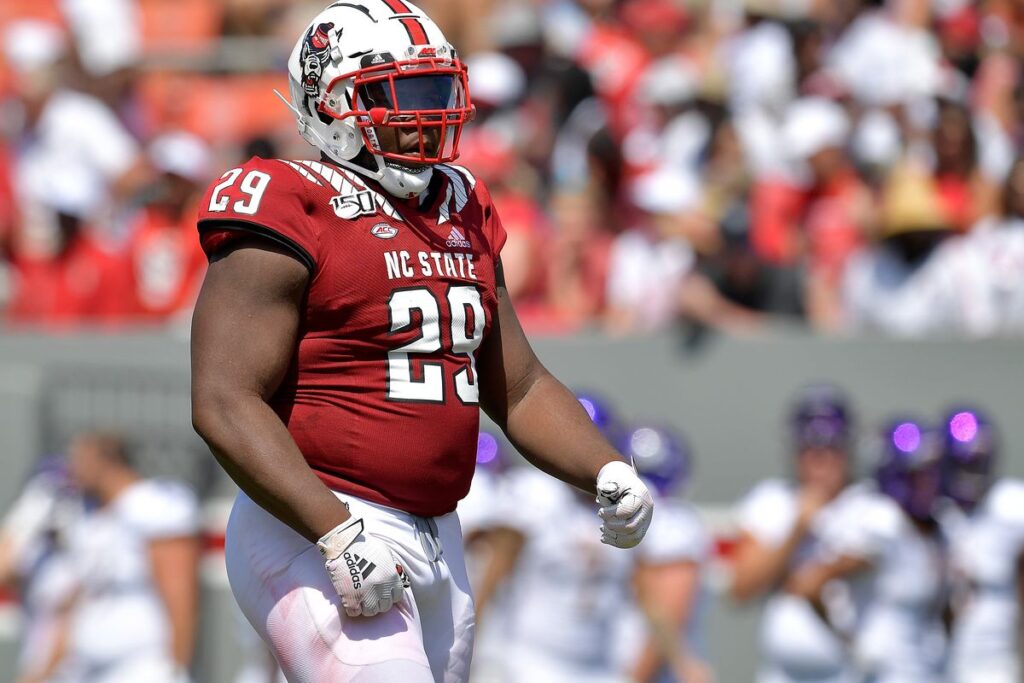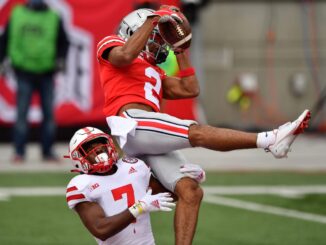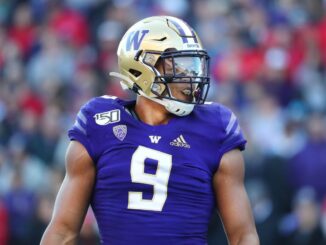This year’s interior defensive line class looks very similar to the tight end group. It is led by a standout talent in Christian Barmore, who may well be the best defensive lineman in the entire class. After that the quality drops off substantially, and I have just four interior linemen inside the top 75 of my Big Board. Here are my top ten interior defensive linemen in the 2021 NFL Draft.
1. Christian Barmore – Alabama

Pros: Barmore is a powerful interior lineman, with really strong hands. He combines this with legitimate explosiveness and showcases great initial burst. Despite being a big guy, he plays with consistently excellent leverage and bends better than most interior linemen. Although his sample size is fairly small he has been the most disruptive interior lineman in college football over the past two years. Barmore has registered 65 pressures and 11 sacks across 492 pass rushing snaps over the last two years. His best games actually came against top competition and he had 12 pressures in his final two games against Notre Dame and Ohio State.
Cons: Barmore only became a full-time starter for Alabama in 2020, having played just 269 snaps in 2019. His sample size is amongst the smallest in this class, with just 747 career snaps. Whilst he has shown the ability to be a game-wrecker, his game-to-game consistency is not where it could be. There were several occasions where he went missing, most notably against Florida and Tennessee. Barmore has been an excellent pass rusher, but at this point he doesn’t offer the same ability against the run. His technique could certainly improve and he tends to play tall.
Projection: 1st round
2. Alim McNeill – NC State

Pros: McNeill offers the ideal combination of size and explosiveness. His quickness off the line of scrimmage is amongst the best in this year’s class and allowed him to cause problems in the passing game. Despite playing as a nose tackle and lacking pass rushing technique, McNeill’s quickness and burst allowed him to push the pocket and create pressure up front. He has heavy hands and plays with good leverage for a man his size. He is also one of the best run defenders in the class, with the anchor strength to handle double teams. According to PFF, McNeill had the third highest run defense grade of any FBS interior linemen in 2020.
Cons: At the moment, McNeill is more of a pocket pusher than a pass rusher. In college he has won primarily as a result of his physical tools, and doesn’t offer much in terms of pass rushing moves. This won’t be enough to get by in the NFL and he needs to improve as a technician. McNeill can also be a little undisciplined with his rushing style and tends to be something of a bull in a china shop. He was often rotated in and out of the line-up at NC State and at seemed to struggle with maintaining his effectiveness throughout the game.
Projection: 2nd round
3. Milton Williams – LA Tech

Pros: Williams is one of the most athletic prospects you will ever come across at the position. His 38.5″ vertical jump is the best ever at the position and he ran a 4.67 40-yard dash at 284 lbs. This all shows on tape too and he has excellent quickness off the line of scrimmage. Williams was an excellent pass rusher in college and his 20.9 per cent win rate led all draft-eligible interior linemen in 2020. His hand usage is impressive and he displays a good variety of pass rushing moves. Williams is also solid against the run, with the ability to consistently stack and shed. He ranked as the second highest graded interior run blocker in 2020 per PFF.
Cons: The most obvious concern with Williams is his size. At just 6’3″ and 284 lbs he is a tweener and teams will have concerns about whether he can stick at the position in the NFL. He also measured in with 31.5″ arms, which ranks in the fifth percentile at the position. Whilst his excellent hand usage and play strength help mitigate this, it is still going to be a concern. He didn’t face much in terms of quality opposition at LA Tech either, and there will be questions about how he will translate to the NFL level. Williams hasn’t had a tonne of experience as an interior lineman either, moving inside from edge rusher in 2020.
Projection: 3rd round
4. Levi Onwuzurike – Washington

Pros: Onwuzurike showcases great initial burst and is one of the more explosive interior pass rushers in this year’s class. He does a nice job of getting his hands inside the frame of his opponent early in the rep and wins regularly with his bull rush move. Whilst he didn’t have a tonne of sacks in college, Onwuzurike showed that he could be a disruptive presence in the passing game, racking up 57 pressures on just 466 pass rushing snaps between 2018-19. This was despite spending a large amount of his time at nose tackle. He is a solid run defender too and shows the ability to read the game well.
Cons: Whilst Onwuzurike had success as a pass rusher, he struggles if his first move is not successful. He hasn’t shown the ability to combo his moves effectively and often gets stuck on blocks as a result. He was also often able to win on the back of his burst and athletic ability, rather than through technique, which won’t translate to the NFL. Onwuzurike has a habit of playing tall and needs to do a better job as far as leverage is concerned. His pad level gets too high and allows opponents to get inside his frame.
Projection: 3rd round
5. Osa Odighizuwa – UCLA

Pros: Despite not being the biggest player at the position, Odighizuwa is one of the longest interior linemen you will find. He boasts 34″ arms, which allow him to control the rep and keep his opponents at a distance. He does a great job of keeping his chest clean from contact and packs real power into his punches. Some will have concerns about his size, but he plays with far more physicality and strength than his frame would suggest. He showcases good initial burst that allows him to be a factor as a pass rusher. UCLA used him in a variety of roles and he spent time at edge rusher, defensive tackle, and nose tackle. He plays the game with a consistently high motor.
Cons: Despite his evident strength, teams are still going to be concerned about his size. He is 6’2″ and 282 lbs and could struggle in the NFL if he doesn’t add some more weight to his frame. Some may see him as an edge rusher, but has only played there sparingly in college. He also lacks the agility you might expect from an undersized prospect, which raises further questions about any transition to edge rusher. Odighizuwa is another player who has issues with his pad level and runs notably high.
Projection: 3rd round
6. Marvin Wilson – Florida State

Pros: Wilson has immensely powerful hands that shock opposing linemen on contact. He is a big and physical player who is tough to contain one-on-one. He has good anchor strength and won’t be moved off the line of scrimmage in the running game. Wilson has some of the most refined pass rushing moves in this year’s class and has shown the ability to combo them to great effect. His 2019 tape was hugely impressive and he had 26 pressures and five sacks on just 291 pass rushing snaps. Wilson has shown the ability to be a force as a run defender too and does a good job of maintaining gap integrity.
Cons: Wilson was considered one of the better interior prospects entering 2020 but he was hugely underwhelming this season. He looked nothing like the player we had seen previously, before suffering a season ending injury after six games. Part of this was the result of Florida State’s switch to a three-man front in 2020, but that excuse only carries so much weight. Wilson isn’t the quickest lineman off the snap either and lacks the burst you ideally want in a prospect. He looked to be carrying some bad weight last season and he seemed sluggish. His pass rush win rate of 12.7 per cent ranked just 43rd at the position.
Projection: 3rd round
7. Tommy Togiai – Ohio State

Pros: Togiai offers excellent power at the point of attack and possesses a mean bull rush. He stands at 6’2″ and 300 lbs, but plays bigger than his size would suggest. He combines this with decent burst and quickness to threaten as a pass rusher and had 24 pressures on 189 pass rushing snaps in 2020. His hand usage is impressive and he does a nice job getting inside the frame of his opponents. He has flashed some nice counter moves at times. Togiai has also shown that he can be a force in the run game and has a solid anchor to stand in and make plays. He ranked as the fourth highest graded draft-eligible interior run defender in 2020 per PFF.
Cons: Togiai’s sample size is incredibly limited. He only became a starter for Ohio State in 2020 and still only played 291 snaps all season. His 659 career snaps rank as the fewest on this list. Whilst his tape was encouraging, we haven’t seen enough to really know how he will fare as a starter in the NFL. He lacks ideal length and struggles to disengage if linemen are able to get inside his pads. This isn’t helped by his poor leverage, which allows his opponents an easy shot at his chest.
Projection: 3rd round
8. Daviyon Nixon – Iowa

Pros: Nixon is a solid athlete, who showcases good initial burst off the line. His athleticism was on show against Penn State, where he managed a 71-yard pick six. His lateral quickness is impressive too, and he was effective when used on stunts and games. Nixon pairs this with the strength you want from an interior lineman and plays above his listed weight. Despite only starting nine games in his college career, he plays with impressive technique. Nixon showcases consistently great leverage and has a nice variety of pass rushing moves in his arsenal.
Cons: Whilst Nixon had some incredible games in 2020, he lacks the consistency you want from a prospect. His 8.5 sacks in 2020 didn’t really tell the full story. He actually logged just 21 pressures on 256 pass rushing snaps and his 10 per cent win rate ranked just 116th in 2020. Nixon has only registered three or more pressures in five of his 21 games at Iowa. Whilst he has a number of pass rushing moves to choose from, he lacks the ability to combo effectively and often finds himself stuck on blocks.
Projection: 4th round
9. Jonathan Marshall – Arkansas

Pros: Marshall has the ideal combination of size and athleticism. He posted a 9.99 Relative Athletic Score at his pro day, the best of any interior linemen and the fifth best of any prospect in the 2021 class. His initial get-off is very impressive and he has the burst you want from a defensive line prospect. He combines this with tremendous power and is capable of bull rushing opponents straight back into the pocket. Marshall has the ability to win in a variety of different ways and this is the kind of thing teams want in the NFL. He is still raw, but the tools are all there to be a quality player in the NFL.
Cons: Marshall was a one-year starter at Arkansas and it was clear in 2020 that he was struggling to maintain his effectiveness throughout a full game. Whilst he has all of the traits you want from an interior prospect, he hasn’t shown the ability to put it all together. There wasn’t much in the way of dominant pass rushing tape at Arkansas, although this was partly the result of playing primarily as a nose tackle. Marshall hasn’t yet shown the ability to combo moves and had a pass rush win rate of just 9.7 per cent in 2020. He is also one of the older prospects in the class, turning 24 as a rookie.
Projection: 4th round
10. Tyler Shelvin – LSU

Pros: Shelvin showed himself to be one of the best run-stuffers in college football back in 2019. If you are after a player who can hold his own against double teams and plug running lanes, Shelvin is one of the best players you could possibly find. He has incredibly strength and power and doesn’t get moved off the line of scrimmage. He will necessitate a double team in the running game, and even then he stands a chance to beat them. Despite his size he plays with good leverage and has nice initial quickness off the snap.
Cons: Shelvin is a great run stopper but offers nothing whatsoever in the passing game. He has managed just nine total pressures across his 393 career pass rushing snaps. His 4.7 per cent win rate was the worst of any interior linemen with at least 300 pass rushing snaps in 2019. This is a tough sell in the pass-first NFL. Shelvin has also had issues with weight control and was suspended by LSU for reaching 380 lbs back in 2018. Teams will have concerns about his ability to maintain the conditioning required of NFL defensive linemen.
Projection: 4th round


